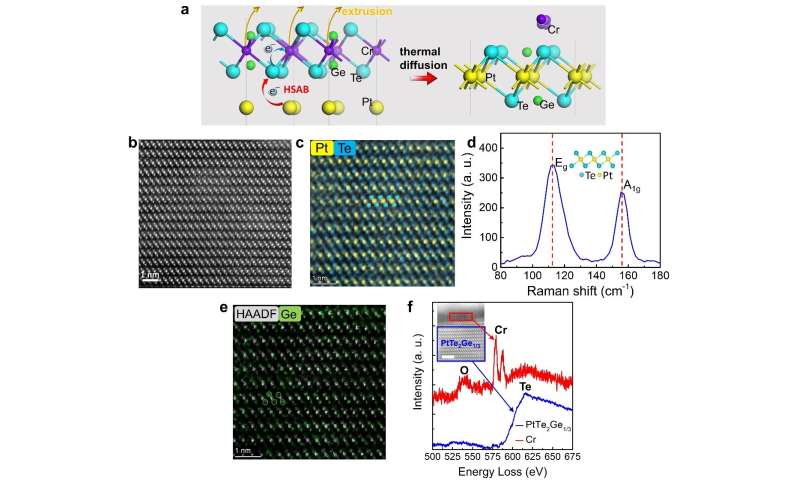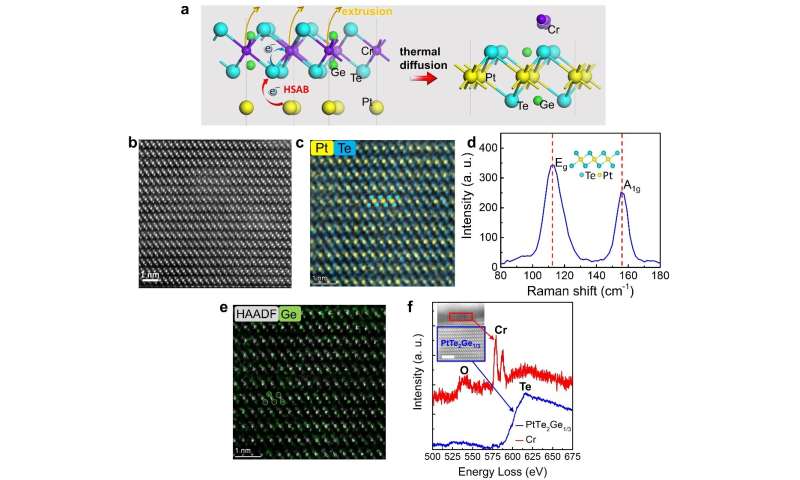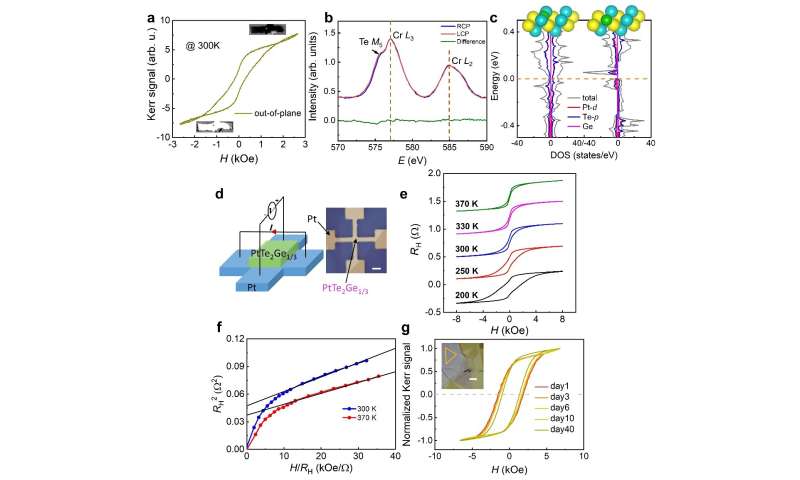Synthesis of air-stable room-temperature van der Waals magnetic thin flakes

Since their recent discovery, two-dimensional (2D) van der Waals (vdW) magnets have become the hotspot in materials science. 2D magnetism has also become one of the most promising fields in the research of condensed matter. With various exciting performance, 2D vdW magnets possess important application potential in topology magnetoelectronics, low power spintronics, quantum computing and optical communication.
Benefited from layered stacking structure, thin flakes of vdW magnets can be easily exfoliated from crystals and flexibly constructed into heterostructures. Therefore, compared to traditional magnetic thin films, they exhibit superior interfacial effects and novel physical phenomena. However, every coin has two sides, vdW magnets have two serious weaknesses. Their Curie temperature (TC) is generally much lower than room temperature and the thin flakes will be rapidly oxidized in air, which leads to difficulties in both fundamental investigations and practical applications. Therefore, the evaluation of TC and air stability has become one of the research focus of vdW magnetic materials, which is of great significance for their practical applications.
Led by Prof. Feng Pan and Prof. Cheng Song (Key Laboratory of Advanced Materials, School of Materials Science and Engineering, Tsinghua University), the research team analyzes the origin of those weaknesses of vdW magnets and designs an anomalous displacement reaction to synthesize novel vdW magnetic thin flakes which possess both room-temperature TC and high air stability.
-

(a) Schematic of the phase transition dominated by HSAB principle (b) High-angle annular dark-field scanning transmission electron microscopy (STEM) cross-sectional image of the reacted t = 14 nm sample. (c) Atomic-resolution energy dispersive spectrometer (EDS) mapping of Pt and Te elements. (d) Raman spectrum of the obtained sample. The inset shows the lattice structure of PtTe2. (e) EDS mapping of the Ge element. (f) Electron energy loss spectroscopy (EELS) spectra of vdW PtTe2Ge1/3 (blue square) and the substituted Cr on the surface (red square). The double peaks around 584 eV, single peaks around 532 eV and 615 eV are features of Cr, O and Te, respectively. Inset shows the low-resolution image. Scale bar: 2 nm. The top bright layer in the image is the protective layer (platinum) for the preparation of STEM samples. Credit: Science China Press -

(a) Out-of-plane Kerr signal measured at 300 K. The insets show the images captured by Kerr microscope under positive and negative magnetic fields. (b) Cr L2,3-edge X-ray absorption measurements performed using the right-circular polarized (RCP) and left-circular polarized (LCP) lights in an applied magnetic field of 4.5 kOe at 200 K and the corresponding difference of two X-ray absorption spectra signals shows the absence of X-ray magnetic circular dichroism (XMCD) of Cr element. The relative intensity compared to the background is exhibited. (c) Density of states calculations of Ge atoms located at the interstitial position between two Te atoms and the substitution position of Te atoms. Corresponding lattice structures are shown in the insets. Yellow, blue and green balls represent Pt, Te and Ge atoms, respectively. (d) Schematic of transport measurement setup and the optical microscope image of the device. Scale bar: 10 μm. (e) Out-of-plane magnetic field dependent anomalous Hall resistance (RH) at representative temperatures from 200 to 370 K of PtTe2Ge1/3. (f) Arrott plots of PtTe2Ge1/3 at 300 and 370 K. (g) Kerr signals of the sample measured at room temperature after exposed in air for days. The inset exhibits the optical microscope image of the sample. Scale bar: 10 μm. Credit: Science China Press
The research team puts forward that the easy oxidation of traditional vdW magnetic materials can be explained by Hard-Soft-Acid-Base principle (HSAB) which illustrates the instability between incompatible elements. Meanwhile, the low TC can be enhanced by strong spin-orbit coupling. Accordingly, inducing magnetism by high-density ordered nonmagnetic doping in naturally stable vdW nonmagnetic materials with strong spin-orbit coupling (PtTe2) is a feasible way to realize room-temperature and stable vdW magnets. The problem seems to be solved here. However, based on traditional methods, it is hard to introduce layered uniform doping with high density, tending to form segregated doping or second phases. Inspiration comes from a traditional vdW magnet Cr2Ge2Te6, in which Ge atoms have already been uniformly arranged in Cr-Te vdW lattice. The team consider whether Pt can replace Cr atoms of Cr2Ge2Te6 in the displacement reaction, while the original Ge atoms could be naturally embedded in Pt-Te vdW lattice and induce long-range ordered ferromagnetism. This displacement reaction seems opposite to the order of metal activity (Cr > Pt), but HSAB shows Pt can be more tightly bonded with Te compared to Cr, which can also dominate this reaction.
The experiments start from the fabrication of Cr2Ge2Te6/Pt heterostructure, followed by the annealing process to provide activation energy for the reaction. Satisfactorily, the results are consistent with the theoretical expectation. The structural characterizations demonstrate that in thin samples, Cr atoms are completely substituted by Pt atoms and PtTe2 vdW structure is formed with the layered uniform insertion of Ge atoms. A novel vdW thin flake PtTe2Ge1/3 is obtained. "Although this surprising reaction is different from traditional cognition but still reasonable." Prof. Song said, "VdW materials always exhibit unexpected phenomena."
Furtherly, both room-temperature TC and high air stability in PtTe2Ge1/3 are demonstrated. Through the optical and electrical measurements, the above room-temperature ferromagnetism is observed. Based on the first-principle calculations, the ferromagnetism is attributed to the unbalanced Pt-Te orbital hybridization with the embedded Ge atoms. The persistence of magnetism with exposure in air for months demonstrates the high air stability of PtTe2Ge1/3.
"The realization of high air stability in room-temperature vdW ferromagnetic thin flakes is a breakthrough in vdW magnets which would advance both the investigation and application of vdW magnetic materials." Prof. Pan said, "The idea of displacement reaction could also be enlightening for the researches among different vdW families."
More information:
Wenxuan Zhu et al, Anomalous displacement reaction for synthesizing above room-temperature and air-stable vdW ferromagnet PtTe2Ge1/3, National Science Review (2022). DOI: 10.1093/nsr/nwac173
Provided by Science China Press